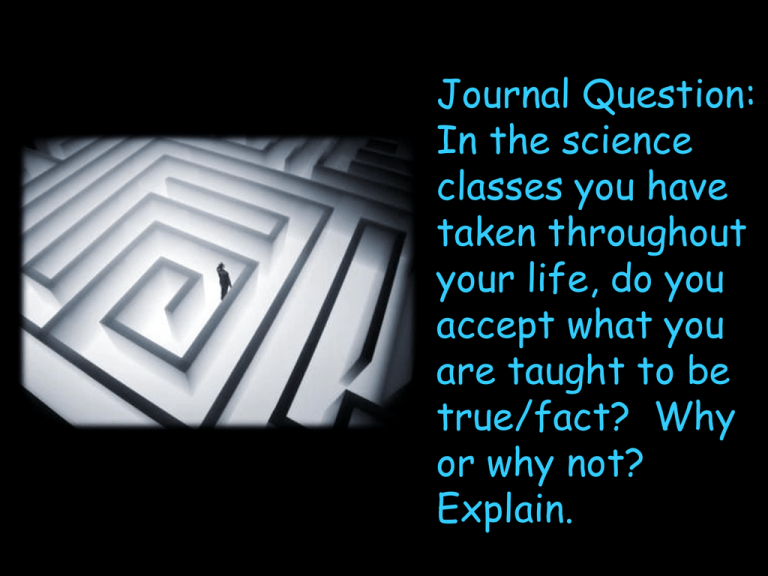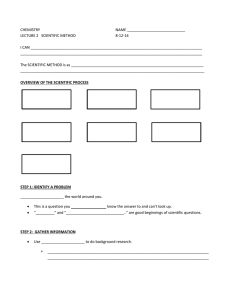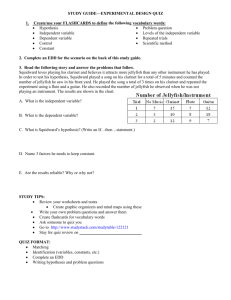Scientific Method Notes Powerpoint
advertisement

Journal Question: In the science classes you have taken throughout your life, do you accept what you are taught to be true/fact? Why or why not? Explain. “Good science is good observation!” What does that mean? “It is when scientists observe something they have never seen before that they can begin to learn something new about how the world works, and perhaps fix any flaws in their old ideas.” Explain what this quote means. Pouring Water Demonstration What will happen when you fill a cup with water and then turn it over? Why is it important for scientists to REPEAT their experiments many times over? How do you collect data? OBSERVATION What type of data can you collect? Quantitative Data – numbers (1,2,3,4…) Qualitative Data – descriptive words (smooth, red, wrinkled…) I, Robot Worksheet I, Robot: Is Vivian Living? YES 1. Grow and Develop 2. Made of Cells 3. DNA 4. Metabolism 5. Reproduce 6. Respond to Env. 7. Homeostasis 8. Die NO How The Scientific Method Works: Scientists use Controlled Experiments: Experiments that use a control group and experimental group Everything about the control group and experimental group(s) are identical, except the experimental group(s) contains the variable, or factor being tested, while the control group does not. Let’s look at an example. Constants are components of the controlled experiment that are kept the same in both the control and experimental groups. How The Scientific Method Works: 1. Observation The bushes in my yard don’t all grow at the same rate 2. Question Does the type of light a plant receives affect its growth? 3. Hypothesis (def: testable explanation) If I expose several plants to different amounts of light, then they will grow at different rates How The Scientific Method Works (Con’t): 4. Test (listed in steps) Expose several plants to different amounts of light. Must include the following things: Independent Variable/Manipulated Variable? (thing you physically Amount of light change) __________ Dependent variable? Responding Variable (thing you measure) Height of each plant over time ____________ Constants? - Species of Plant - Type of soil - Amount of water -Temperature - height/condition that each plant starts in (seeds?) Setup How will ensure that all variables are eliminated but one….hypothetical experiment is one thing, actually doing it is very challenging How The Scientific Method Works (Con’t): 5. Results: You must decide: How often to collect data. Using what instruments How data will be collected? Be consistent for all of these things Data must be organized into charts, graphs, images, video, etc. 6. Conclusion - Your conclusion must only be based on your results. - Do the results support your hypothesis? If not, must do further testing. Revise hypothesis and start again - All controlled experiments must be repeated many times to increase validity How would you test whether or not Lancermycin, a new drug, treats strep throat? Control group Experimental Group Independent Variable Dependent Variable Constants Altoids Lab: Practice with the Scientific Method Let’s brainstorm some common things that people claim: I’ll start us out. 1. Bulls get angry at the color red. What you must include: Scientific Question Hypothesis (if/then format) Test/experiment (details) Control group Experimental group Constants Manipulated variable Responding variable YOU NEED YOUR TEXT BOOK TODAY! JQ: Squidward loves playing his clarinet and believes it attracts more jellyfish than any other instrument he has played. In order to test his hypothesis, Squidward played a song on his clarinet for a total of 5 minutes and counted the number of jellyfish he saw in his front yard. He played the song a total of 3 times on his clarinet and repeated the experiment using a flute and a guitar. He also recorded the number of jellyfish he observed when he was not playing any instrument. The results are shown in the chart below. Answer the following questions. A. Write Squidward’s hypothesis in an “If, then” format B. What is the Control Group? C. What is the Experimental group(s)? D. What is the manipulated variable? E. What is the responding variable? F. What can you conclude from the data? (hint: calculate averages) JQ: A research lab at Rutgers wants to study the effects of Red Bull on mice’s level of physical activity. Answer the following questions: A. Describe a basic setup for your experiment B.Write a hypothesis in an “If, then” format C. What would the Control Group be? D. What would the Experimental group be? E. What is the Independent variable? F. What is the Dependent variable? G. Constants? YOU NEED YOUR TEXT BOOK TODAY! JQ: A research lab at Rutgers wants to study the effects of a pesticide called Aramite on the ability of tomato plants to produce tomatoes. The lab believes that tomato production is being stunted, but the manufacturer of Aramite claims it does not affect the plants. A. Write a hypothesis in an “If, then” format B. What would the Control Group be? C. What would the Experimental group be? D. What is the Independent variable? E. What is the Depenedent variable? F. Constants? Today: 1. Review your practice experiments 2. Altoids Lab 3. Design Your Own Experiment (DYOE) Discussion 4. Complete K’Nex Following Directions Homework: Complete Altoids Lab and K’Nex Following Directions Activity: Why is it important to follow directions? Why is it important to define the world around us using the same words? Why is it important to be able to communicate your thoughts through writing? Following Directions Activity: 1.As you build something with the K’nex, create clear, detailed instructions for how you are building it (as if you were writing the instruction booklet) 2. Completely take apart what you have made. Leave the instructions and K’nex at your table. 3. Move to someone else’s lab table, and try to build what they have described 4. Let’s define what to call each type of piece. JQ: Is an Avatar living or non-living?



